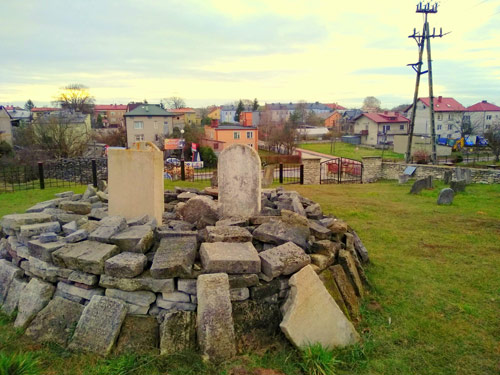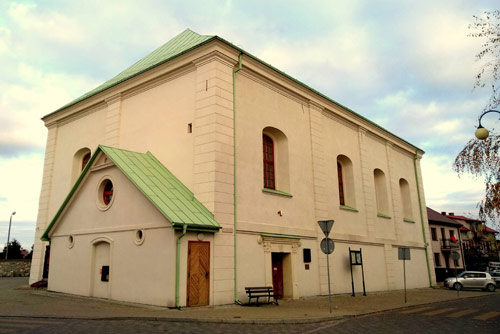Shtetl Stories Private One Day Tour
- Kazimierz Private Tour - Highlights of Jewish Heritage
- 2 in 1 Day - Krakow Old Town and Kazimierz Jewish Quarter Private Tour
- Krakow Old Town Highlights Private Tour
- Schindler's List Private Tour
- Schindler's Factory Private Tour
- Krakow Ghetto Private Tour
- KL Plaszow Camp Private Tour
- Combined Tours
- Shtetl Stories Private One Day Tour
- In the footsteps of Rutka Laskier - Polish Ann Frank from Będzin Private Tour
Tarnów - Dąbrowa Tarnowska - Chmielnik
We would like to invite you for a tour that traces Jewish heritage of Galicia and discovers the character and atmosphere of traditional shtetls. One still can find places and buildings that remain that unique phenomenon of Jewish existence in Poland.
The name Polish Galicia refers to that part of southern Poland which in the 19th century was part of Austrian - Hungarian Empire ( the result of partitions of Poland ) and in many ways developed its own local identity as distinct from the rest of Poland. This territory had an extremely dense Jewish population before the Second World War, which was almost completely wiped out during the Holocaust. However, there are many physical traces of that Jewish past that have survived - empty synagogues, abandoned cemeteries, as well as Holocaust memorials dotted around the countryside.
Shtetl (little town) was known only in Eastern Europe and was inhabited by the Jews.There were streets, houses, mikhvas, prayer houses, little shops, workshops, and cemeteries. Life was concentrated in a marketplace and Yiddish was heard everywhere. It gained certain independence and uniqueness.
All the Galician Shtetls were gone with the WWII when the Jewish life was brutally interrupted by the Nazi Germans.
Tarnów - lies on the south-eastern part of Poland and has one of the most beautiful old towns. Before the WWII had a population of 56.000 inhabitants which 25.000 were Jews ( 45%). Jewish Tarnow was famous for having many intellectuals: lawyers, physicians, teachers and industrialists that had a huge impact on this town. Tarnow was also an important centre of Orthodox Jewish religious life with many synagogues, prayer houses, schools. On the other hand, Jewish Enlightenment and reform movements influenced here as well.
The route leads through the most important sites connected with the history of Tarnow Jews:
- Market Square
- Jewish historical Quarter with the oldest streets
- The remnants of Old Synagogue
- Wałowa street
- Goldhammera Street
- The former area of Tarnow ghetto
- Building of former Mikvah
- Memorial of the first transport of inmates to Auschwitz
- Jewish Cemetery - one of the best preserved and oldest in southern Poland
Dąbrowa Tarnowska - small town as a typical Galician shtetl where two interweaving cultures, Jews, and Christians had coexisted side by side. There was also one of the Hassidic dynasties founded. Before WWII Dąbrowa had a large Jewish community with almost 2500 inhabitants. At the end of the war, about 50 Jews returned to Dąbrowa but unfortunately, there is none of them now there.
- Dąbrowa Synagogue reminds those days. It is the best example of bringing back the dignity and memory of the shtetl. It was renovated in 2012 by the local municipality and is a masterpiece of its kind with a rich decoration inside. The building is housing the Center for the Meeting of Cultures in Dąbrowa Tarnowska. The exhibition is dedicated to history of Jews from the area.
- There is also a Jewish 17th-century cemetery with only a few thumbs left and Ohel of the rabbis from the Unger dynasty.
Chmielnik - since 1795, after the third partition of Poland, it was situated in Austria (Province - New Galicia). After 1809, Chmielnik belonged to the Grand Duchy of Warsaw and following the Congress of Vienna, since 1815 to Russia. Chmielnik was this kind of shtetl in which Jews constituted a majority and decided about its specific character. Together with Poles, they created the history of the town. They built it and organized its social and economic life. In Chmielnik, they found for themselves a friendly place for the next few centuries.
- Synagogue built in 18th-century was carefully restored and is now housing a unique museum where the historical elements coexist with the interactive ones.
- The Market Square in Chmielnik the architectural layout dates back to the 19th century when the town was rebuilt after the great fire of 1876.
- Old Jewish Cemetery (near the synagogue) established in the 17th century. The majority of tombstones have been destroyed after WWII. Nowadays, the House of Shadow is located there - a monument and a symbol of remembrance of the victims of the Holocaust.
- New Jewish Cemetery established in 1820. Nazi Germans completely destroyed this area during WWII.
All day










- Kazimierz Private Tour - Highlights of Jewish Heritage
- 2 in 1 Day - Krakow Old Town and Kazimierz Jewish Quarter Private Tour
- Krakow Old Town Highlights Private Tour
- Schindler's List Private Tour
- Schindler's Factory Private Tour
- Krakow Ghetto Private Tour
- KL Plaszow Camp Private Tour
- Combined Tours
- Shtetl Stories Private One Day Tour
- In the footsteps of Rutka Laskier - Polish Ann Frank from Będzin Private Tour
